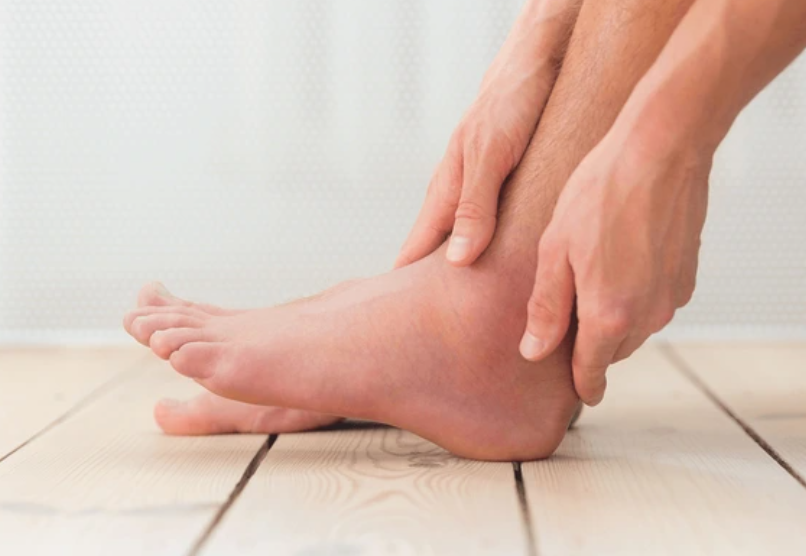Foot pain can significantly impact one’s quality of life, and while musculoskeletal conditions are common culprits, certain pathological conditions can also manifest similarly. Identifying the correct cause is essential for effective treatment. Here are five pathological causes of foot pain that often mimic musculoskeletal pain, their signs and symptoms, and tips to differentiate between these pathological causes and musculoskeletal conditions at home. Please note that while it’s good to be aware of the differences, this guide is by no means meant to substitute assessment by a trained health professional. If you think you have one of these below conditions or you are experiencing foot pain, go seek help from your medical or allied health practitioner.
1. Peripheral Neuropathy
Signs and Symptoms: Tingling or burning sensation; Numbness in the feet; Sharp, jabbing, or electric-like pain; Sensitivity to touch
Home Differentiation Tips: Check for Patterns: Neuropathic pain often follows a specific nerve distribution and is constant, whereas musculoskeletal pain typically varies with movement and activity. If pain worsens with changes in temperature, it may indicate nerve involvement. Peripheral neuropathy often affects both feet symmetrically, whereas conditions like plantar fasciitis are usually on one side only.
Mimicked Musculoskeletal Conditions:
a. Plantar Fasciitis: Heel pain and stiffness, usually worse in the morning.
b. Stress Fractures: Localized pain and tenderness, typically after activity.
2. Peripheral Artery Disease (PAD)
Signs and Symptoms: Painful cramping in the hip, thigh, or calf muscles after activity; Leg numbness or weakness; Coldness in the lower leg or foot; Sores on toes, feet, or legs that won’t heal
Home Differentiation Tips: Pale, bluish, or cold skin can indicate poor circulation and a possible arterial issue. PAD pain typically worsens with activity and improves with rest, unlike musculoskeletal pain which may worsen with specific movements or positions. Weak or absent pulses in the feet compared to the hands may suggest PAD. You can check your foot pulse by pressing two fingertips into the meaty part behind the ankle on the inside of your leg. You can check your wrist pulse by placing two finger tips on the palmar & thumb side of you wrist where the skin looks thin.
Mimicked Musculoskeletal Conditions:
a. Achilles Tendinitis: Pain and stiffness along the Achilles tendon, especially in the morning.
b. Shin Splints: Pain along the shin bone, often due to overuse.
3. Rheumatoid Arthritis (RA)
Signs and Symptoms: Joint pain and swelling; Morning stiffness lasting more than 30 minutes; Fatigue and fever; Symmetrical joint involvement
Home Differentiation Tips: RA-related stiffness lasts longer than 30 minutes. However, this is not a clear indicator of arthritic differentiation. RA often affects the same joints on both sides of the body. Presence of fatigue, fever, or weight loss alongside joint pain could be indicators of RA. Usually systematic symptoms like these accompany pain indicating something more severe than a local ailment is present.
·Mimicked Musculoskeletal Conditions:
a. Osteoarthritis: Involves wear and tear of cartilage, often without systemic symptoms.
b. Gout: Sudden, severe attacks of pain, redness, and tenderness, typically in the big toe.
4. Osteomyelitis
Signs and Symptoms: Fever and chills; Pain and swelling over the affected bone; Redness and warmth; Drainage of pus through the skin
Home Differentiation Tips: Redness, warmth, swelling and pus are strong indicators of infection. Presence of fever alongside foot pain is a usually a red flag for osteomyelitis. Unlike musculoskeletal pain that may improve with rest, osteomyelitis pain often persists and worsens over time. There usually is no positions of pain relief.
Mimicked Musculoskeletal Conditions:
a. Severe Ankle Sprain: Swelling and pain, but without systemic infection signs.
b. Tendonitis: Pain and tenderness, often related to overuse. Localised pain over the location of the involved tendon.
5. Tarsal Tunnel Syndrome
Signs and Symptoms: Tingling, burning, or a sensation similar to an electric shock; Numbness in the foot; Pain, including shooting pain, in the ankle or foot
Home Differentiation Tips: Tap over the area of the tarsal tunnel (inside of the ankle) to see if it reproduces symptoms. Symptoms often worsen with standing or walking and improve with rest. Notice if certain foot positions exacerbate or alleviate pain, which can indicate nerve involvement.
Mimicked Musculoskeletal Conditions:
a. Plantar Fasciitis: Heel pain, but not typically associated with tingling or burning.
b. Ankle Sprain: Pain and swelling, often with a history of trauma.
Foot pain can arise from various pathological conditions that mimic musculoskeletal pain. Differentiating between these conditions at home is very difficult. While these tips can help guide you to help decide if your pain may be from a musculoskeletal or pathological cause, it's essential to seek professional medical advice for an accurate diagnosis and appropriate treatment. If you suspect that you may have a pathological condition causing your pain then you should immediately seek assessment from a medical professional.



